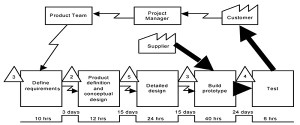
Most Value Stream Mapping is done on totally manmade systems, which exist in hard goods factories, and service businesses, however there are several industries which exist on the merger of manmade systems and naturally occurring ones. Many of these are found in agriculturally related industries, though they can exist in other fields as well.
For these industries trying to map the whole Value Stream for each product would actually add extra waste to the process, without creating any benefit. Natural processes rarely allow for easy process improvement, in fact trying to map them can be more waste than ignoring them. In this brief article I will share a hint to using Value Stream Mapping in these industries without creating needless waste.
Aging Wine is a natural process, which is difficult to perfectly control, this causes problems in creating a Value Stream Map for wineries.
It is easy to break down production into Value Streams and Product Families in manmade manufacturing and service business processes. However, doing so in industries that rely on natural processes occurring is not quite so simple. Despite the fact that the industries dependent upon naturally occurring process are often far less complex, the complexity of the natural process itself pales anything man can create. It is because of that complexity that these processes are often only marginally controllable, and can easily occur across a range of their average plus or minus one third of that average.
Most of our current Lean tools and methods will accomplish nothing in improving that part of the Value Stream. In that case what should these people do in order to use lean to help drive Continuous Improvement?
The answer may not sound perfect to the Lean Purist, but these are grey area businesses; they are a blend of naturally occurring, unalterable processes and manmade, totally controlled ones. But there are certain parts of the process often both before and after the natural process, which are manmade and improvable.
Thus before trying to tackle the natural process, which can often only be improved through extreme levels of environmental controls (often they are just too expensive to use), tackle those sections we humans created. In most cases you will find that these two sections of the Value Stream are so homogeneous that you can reduce the number of product families to far fewer than if you include the natural process.
An example, a winery can often easily define three pre-aging process, one for white wines, one for red wines, and one for the rosy wines. Some highly focused wineries can bring it down to one, as they only really produce one basic type of wine (i.e. red), despite different varieties within the colour group requiring different aging times, the process leading to aging is almost identical.
Additionally a winery can further simplify the post aging processes, as bottling is almost perfectly identical across all their production, only a few minor limiting factors exist such as the pre-bottling storage container size. (Watch for a follow up related to Wine Production in which we will show an example of the VSM creation we would recommend.)
[wpdm_tree category=”vsm-templates”]
By focussing on those sections of the Value Stream they have the most control over.
If we understand that the only processes we as people can create improvements to, are those processes we created and thus can control or change for the better, we will focus on taking actions that make sense, not trying to find a wishful solution to effecting a natural process (effecting natural processes is often very expensive, and often rather risky because you can get an adverse reaction occurring).
Finding opportunities to improve naturally occurring processes involves scientific research, followed by process re-design applying what science has learned, if it is affordable to do so.
This type of Improvement is very periodic in nature and occurs at those times when several advances in science and engineering come together and result in creating new or vastly improved system or process. They bring together the knowledge of the natural process, with an affordable solution to help control it and maintain it in its optimum state.
Value Stream Mapping with Natural Processes applies to a great many agriculturally related processors.
Some industries that come to mind are: Wine (fermentation and aging), Cheese (there are many types of aged cheese), Tobacco (tobacco is aged in many different ways in order to obtain certain tastes), Sausages and Preserved Meats, Preserved Vegetables, Canned Vegetables (water/solids ratio effects processing time a great deal), Fresh Foods (nature can cause major shifts in yield and quality), Spirits and Beer (some types are aged), and Lumber (trees are effected by weather as is drying); and these are just a few bigger examples, I am sure there are many others.
If you are one of these types of industries, work on the part of the Value Stream you can control and change without affecting the product you produce, the part you created. Than as science and technology advance, look for opportunities to apply those advances to your natural systems, changing them will naturally take longer, but remember it is those processes however variable that you rely on for your product, only change them when you are sure they will not adversely affect the product. After all we need to stay in business, and you can only do that by producing the product the consumer wants.

